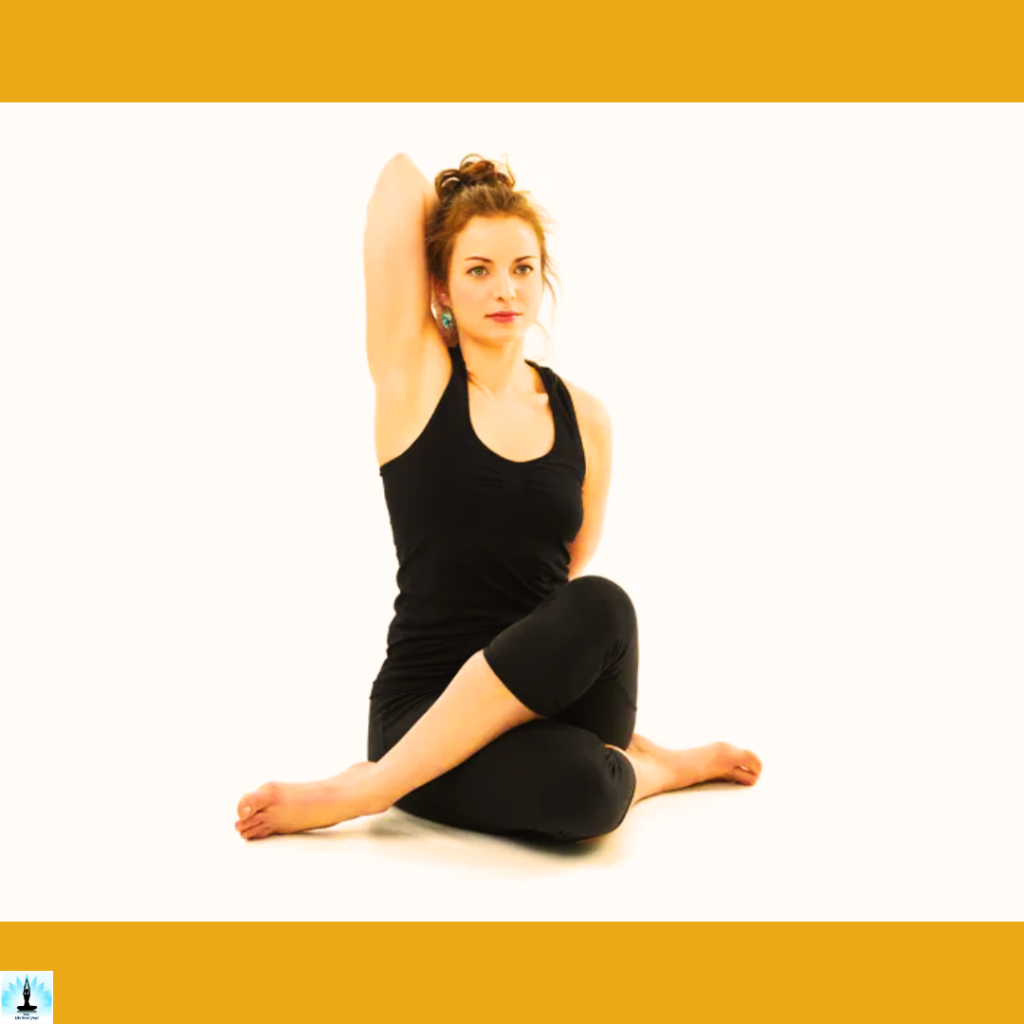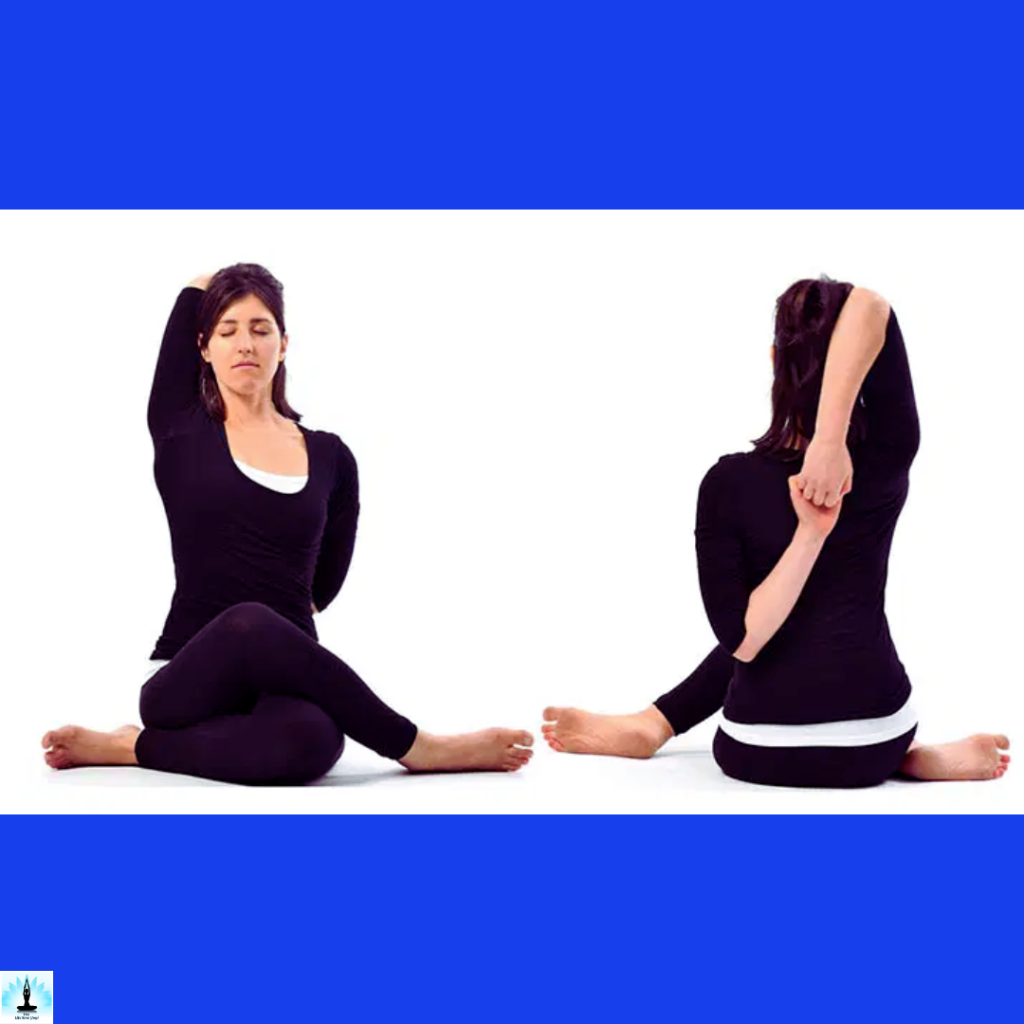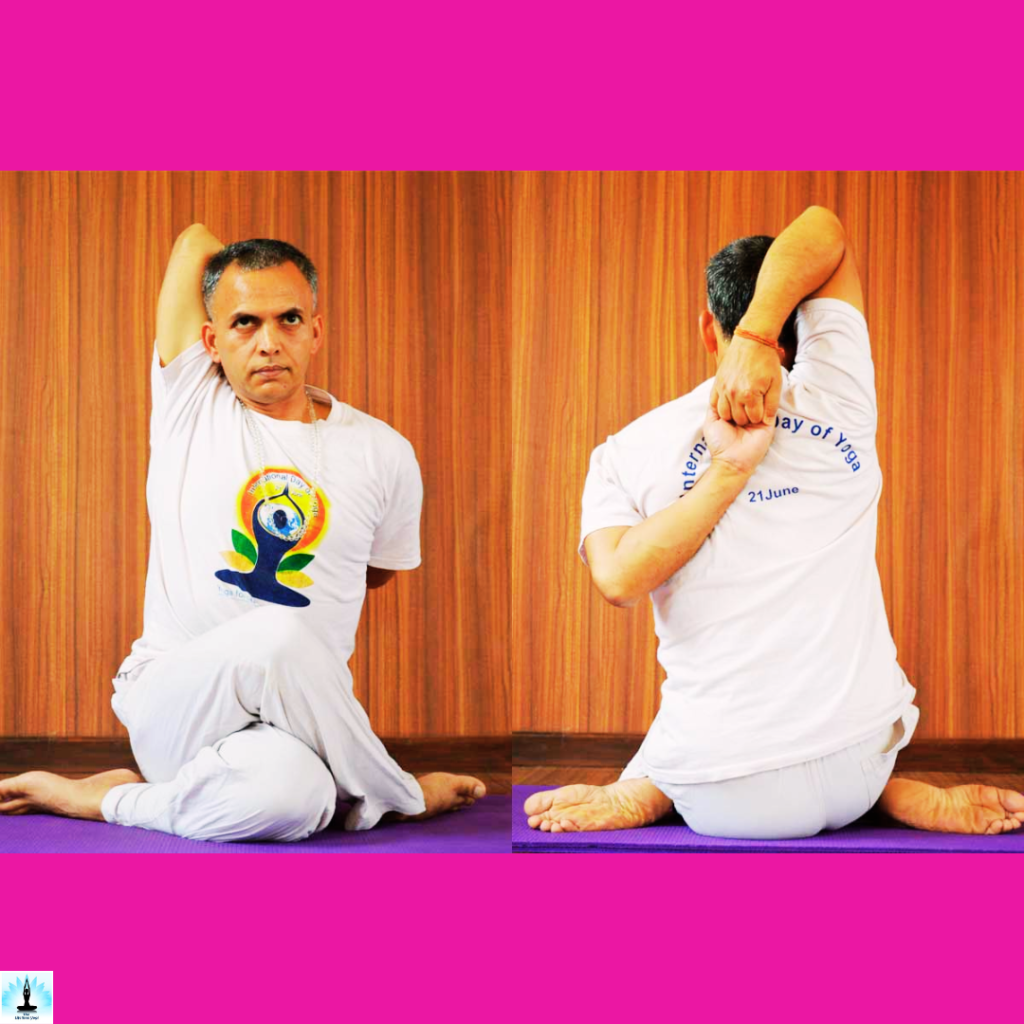Introduction – Top 10 Benefits of Gomukhasana And 12 Step-By-Step Instructions of Gomukhasana
Gomukhasana stretches and mobilizes the hips, thighs, and shoulders, enhancing overall flexibility and promoting a more balanced posture. Its influence extends to the respiratory system, fostering deeper breathing and encouraging a sense of relaxation that helps ease tension and stress. Energetically, Gomukhasana harmonizes the body’s energy channels, promoting the flow of prana and infusing a renewed vitality into one’s being.
As practitioners work to gradually deepen the pose, they are guided to cultivate patience, self-acceptance, and an unwavering focus on the present moment. Gomukhasana teaches that by merging opposing forces and finding equilibrium within ourselves, we can attain a sense of inner unity and balance that extends beyond the mat and into our daily lives.
Table of Contents
The yogic philosophy of the Gomukhasana

The yogic philosophy underlying the Gomukhasana, or Cow Face Pose, is deeply rooted in the concept of balance and harmony within the body and mind. This asana symbolizes the unity of opposites, reflecting the idea that embracing both strength and flexibility, effort and ease, leads to a state of holistic well-being. The physical posture, where the arms are interlocked behind the back resembling a cow’s face, encourages a symmetrical alignment of the body’s energy channels, fostering a sense of equilibrium.
Benefits of Gomukhasana
Here are the benefits of Gomukhasana (Cow Face Pose) explained in bullet points:

- Hip and Thigh Flexibility: Gomukhasana involves stacking one knee over the other, which gently stretches and opens the hips and thighs. This is particularly beneficial for individuals who sit for extended periods, helping to counteract the tightness that can develop in these areas.
- Shoulder Stretch: The interlocking of the arms behind the back stretches the shoulders, chest, and deltoid muscles. This can alleviate tension and improve flexibility in the upper body, especially for those who experience tightness from activities like desk work or carrying heavy bags.
- Spine Mobility: As you draw the spine long while folding forward, Gomukhasana promotes spinal flexibility and alignment. It encourages a healthier posture by counteracting the rounding of the upper back that often occurs due to modern lifestyle habits.
- Deep Breathing: The pose encourages deeper, conscious breathing. The expansion of the chest and lungs facilitates fuller inhalations and exhalations, enhancing lung capacity and oxygen intake. This can help reduce stress and promote relaxation.
- Mindfulness and Focus: Holding the pose requires concentration and awareness of the body’s sensations and limitations. This cultivates mindfulness, drawing your attention to the present moment and fostering a sense of mental clarity and calm.
- Stress Relief: Gomukhasana helps release tension in the shoulders, neck, and hips, areas where stress often accumulates. Mindful breathing and focused attention further contribute to stress reduction, promoting a sense of relaxation.
- Posture Improvement: Regular practice of Gomukhasana contributes to improved posture by aligning the spine and shoulders. This can counteract the slouching or hunching that can result from poor posture habits.
- Digestive Support: The gentle compression of the abdominal area during the pose stimulates digestion and massages the internal organs. This can aid in digestion and alleviate discomfort in the digestive system.
- Energetic Balance: Gomukhasana is believed to balance the nadis, the body’s energy channels. By promoting the harmonious flow of prana (life force energy), the pose can help restore and enhance overall vitality and well-being.
- Unity and Balance: The name “Cow Face Pose” refers to the appearance of the arms resembling a cow’s face. This symbolism represents the idea of embracing opposites and finding balance, both physically and mentally. The pose encourages a sense of unity within oneself.
Cow Face Pose: Step-by-Step Instructions
Here are the step-by-step instructions for practicing the Cow Face Pose (Gomukhasana):

- Start in a Comfortable Seated Position: Begin seated on your yoga mat with your legs extended in front of you. Sit up tall, lengthening your spine, and engage your core muscles to support your posture.
- Bend One Knee: Bend your right knee and bring it towards your chest. Place your right foot on the mat, positioning it close to your left hip.
- Cross the Legs: Cross your left leg over your right thigh. Your left knee should be stacked directly over your right knee. Both knees should ideally be aligned as closely as possible.
- Set Up the Arms: Extend your left arm out to the left, parallel to the floor. Bend your left elbow, bringing your left hand behind your back and towards your upper spine.
- Reach the Right Arm: Extend your right arm up towards the ceiling. Bend your right elbow and reach your right hand behind your back, aiming to bring your hands closer together.
- Bind the Hands: Attempt to interlock your fingers behind your back. If your hands don’t quite meet, you can use a yoga strap or a cloth to bridge the gap between your hands.
- Alignment Check: Ensure that your sitting bones are grounded on the mat and your spine is elongated. Try to maintain an even distribution of weight on both hips.
- Open the Chest: Gently draw your shoulders back and down as you lift your chest. Feel the stretch across your chest and shoulders.
- Option for Forward Fold: If your flexibility allows, you can gently hinge forward at your hips, keeping your spine long. Only go as far as is comfortable, avoiding rounding your back.
- Breathe and Hold: Stay in the pose for several breaths, focusing on deep, mindful breathing. Feel the stretch and the opening in your hips, thighs, and shoulders.
- Release and Switch Sides: To come out of the pose, release your hands, straighten your legs, and shake them out. Then, switch the position of your legs, crossing the right leg over the left, and repeat the steps on the opposite side.
Advance Variations of Gomukhasana
Here are some advanced variations and modifications of Gomukhasana (Cow Face Pose):
Bound Gomukhasana with Eagle Arms: This variation combines Gomukhasana with Eagle Arms. After binding your hands behind your back, bend your elbows, and wrap your right elbow under your left elbow. Bring your palms to touch, creating a “wrapped” or “eagle” arm position. This adds an extra stretch to the shoulders and upper back.
Gomukhasana in Lotus Pose: Begin by sitting in Lotus Pose (Padmasana) and then proceed to practice Gomukhasana arms. This variation provides a deep hip and shoulder stretch, but it requires advanced flexibility in the hips and knees.
Therapeutic Applications of Gomukhasana
Gomukhasana (Cow Face Pose) offers several therapeutic applications that can be beneficial for various physical and mental conditions. Here are some of the therapeutic benefits:
- Shoulder Tension and Pain: Gomukhasana helps release tension and stiffness in the shoulders, making it useful for individuals with shoulder pain, stiffness, or discomfort caused by factors like poor posture, desk work, or repetitive movements.
- Upper Back and Neck Pain: The shoulder and chest opening in Gomukhasana can alleviate upper back and neck pain by stretching and relaxing the muscles in these areas. It can be particularly helpful for those who experience discomfort due to prolonged sitting or screen time.
- Hip Mobility and Pain: Gomukhasana’s hip-opening action can aid individuals with tight hips, hip discomfort, or conditions like sciatica. The pose gently stretches the hip muscles, contributing to increased mobility and reduced discomfort.
- Thoracic Kyphosis: For individuals with rounded upper backs (thoracic kyphosis), Gomukhasana’s chest expansion and spinal elongation can encourage better posture and alleviate some of the roundings.
- Body Awareness and Mind-Body Connection: Gomukhasana encourages a heightened awareness of the body and its sensations, fostering a stronger mind-body connection. This can be particularly useful for individuals seeking to cultivate mindfulness and self-awareness.
- Postpartum Recovery: Gomukhasana, when modified appropriately, can help new mothers gently open and stretch their hips and shoulders, aiding postpartum recovery and reducing muscular tension.
Poses Related to Gomukhasana
Several yoga poses are related to Gomukhasana (Cow Face Pose) in terms of their hip and shoulder opening qualities or their effects on the body-mind connection. Here are some poses that share similar benefits or themes:
Preparatory Poses of Gomukhasana
- Baddha Konasana (Bound Angle Pose): Like Gomukhasana, Baddha Konasana involves hip opening. Sitting with the soles of your feet together, this pose stretches the inner thighs and groins, promoting flexibility and releasing tension.
- Upavistha Konasana (Wide-Angle Seated Forward Bend): This pose opens the hips and hamstrings while providing a forward fold that stretches the spine and encourages a sense of grounding and relaxation.
Follow-up Poses of Gomukhasana
- Garudasana (Eagle Pose): Garudasana involves wrapping one leg around the other and one arm around the other in a way that resembles Gomukhasana. It provides a deep stretch for the shoulders and hips while improving balance and concentration.
- Parsva Sukhasana (Easy Seated Side Stretch): This gentle seated stretch involves a side bend, which can help open the sides of the torso and encourage spinal mobility, complementing the effects of Gomukhasana.
Beginner’s Tip of Gomukhasana
here are some helpful tips to consider:
1. Prepare Your Hips
Before attempting the full pose, warm up your hips with gentle stretches. Sit cross-legged and gently sway your knees up and down to loosen the hip joints. This will make it easier to stack your knees in Gomukhasana.
2. Use a Prop
If your hands cannot comfortably clasp behind your back, use a yoga strap, towel, or even a shirt to bridge the gap between your hands. Hold the prop in one hand and reach the other hand behind your back, gradually working towards bringing your hands closer over time.
Contraindications and Cautions of Gomukhasana
Gomukhasana (Cow Face Pose) can offer various benefits, but it’s important to be aware of its contraindications and practice it with caution, especially if you have certain medical conditions or limitations. Here are some contraindications and cautions to consider:
Knee Injuries
Avoid Gomukhasana if you have acute or chronic knee injuries, such as recent surgeries, ligament tears, or inflammation. The stacking of the knees can place stress on the knee joints, potentially exacerbating the condition.
Shoulder Injuries
Individuals with shoulder injuries, such as rotator cuff issues, should approach Gomukhasana with caution. Binding the hands behind the back may strain the injured shoulder, so it’s advisable to modify the pose or skip it altogether.
Hip Injuries
If you have severe hip issues, such as hip replacements or hip impingements, Gomukhasana may not be suitable. Consult with a healthcare professional or experienced yoga teacher for guidance on safe modifications.
Ankle or Wrist Injuries
Avoid the pose if you have recent ankle or wrist injuries, as the seated position may place additional strain on these areas.
FAQs on Gomukhasana
Here are some frequently asked questions (FAQs) about Gomukhasana (Cow Face Pose), along with their answers:
1. What is Gomukhasana?
Gomukhasana, also known as Cow Face Pose, is a yoga asana that involves the crossing of the legs and the interlocking of the arms behind the back, resembling a cow’s face. It offers various benefits for the hips, shoulders, and spine.
2. What are the benefits of Gomukhasana?
Gomukhasana stretches and opens the hips, thighs, and shoulders. It improves flexibility, enhances posture, stimulates the chest and lungs, and promotes relaxation. Energetically, it balances the body’s energy channels, fostering a sense of unity and vitality.
3. How do I perform Gomukhasana?
Start by sitting on the floor. Cross one leg over the other, stacking the knees if possible. Extend one arm out to the side, bend it, and reach behind your back. Extend the other arm up, bend it, and reach behind your back to interlock the hands. You can modify with props if needed.
4. Can beginners practice Gomukhasana?
Yes, beginners can practice Gomukhasana, but it’s important to approach it with awareness and patience. Using props and modifications can help make the pose more accessible for those new to yoga.
5. What if I can’t bind my hands?
If you can’t bind your hands behind your back, use a yoga strap or a prop to bridge the gap between your hands. Hold the strap in one hand and reach the other hand behind your back, gradually working towards the bind.
6. Are there any contraindications for Gomukhasana?
Gomukhasana should be avoided if you have knee, shoulder, or hip injuries, or if you’re pregnant. Individuals with certain spinal conditions should also practice with caution. Always consult a healthcare professional before attempting the pose if you have any concerns.
7. How long should I hold Gomukhasana?
You can hold Gomukhasana for about 30 seconds to a minute on each side. Remember to focus on your breath and avoid pushing yourself too far into the stretch.
8. Can Gomukhasana help with stress and anxiety?
Yes, Gomukhasana’s mindful breathing and focus on the present moment can help reduce stress and anxiety. The pose promotes relaxation and a sense of calm.
9. Is Gomukhasana a good preparatory pose for meditation?
Yes, Gomukhasana’s focus on mindfulness and breath awareness can make it a suitable preparatory pose for meditation. It can help calm the mind and create a sense of presence.
10. Can I practice Gomukhasana during pregnancy?
Gomukhasana is generally not recommended during pregnancy, especially as the belly grows. It’s best to focus on poses that are more comfortable and supportive for prenatal practice.
Conclusion
In conclusion, Gomukhasana, or Cow Face Pose, is a yoga posture that holds a wealth of benefits for both the body and mind. Through the artful interweaving of hip and shoulder opening, Gomukhasana invites practitioners to explore the delicate equilibrium between strength and flexibility. The pose’s symbolism of unity, mirrored in the interlocking of the arms behind the back, serves as a reminder of the intrinsic connection between opposing forces within ourselves.
Further reading
References
- “Gomukhasana A”. Ashtanga Yoga. Archived from the original on 11 February 2011. Retrieved 29 January 2019.
- Sinha, S. C. (1996). Dictionary of Philosophy. Anmol Publications. p. 18. ISBN 978-81-7041-293-9.
- The Yoga Upanishads. Translated by T. R. Srinivasa Ayyangar. Adyar, Madras: The Adyar Library. 1938. p. 124.
- Sriharisukesh, N.; Pailoor, Subramanya (2019). “A review of asanas referenced in ancient texts and a brief comparative study of selected asanas” (PDF). International Journal of Sanskrit Research. 5 (4): 270–273. ISSN 2394-7519.
- Mallinson, James; Singleton, Mark (2017). Roots of Yoga. Penguin Classics. London: Penguin Books. pp. 116–119. ISBN 978-0-241-25304-5. OCLC 928480104.
- “Gomukhasana (Cow Face Posture)”. The Divine Life Society. 2011. Retrieved 28 January 2019.
Hence, this Asana is suitable for the practice of Pranayama. Ordinarily you can sit at all times in this Asana for long meditation also.
- Mehta, Silva; Mehta, Mira; Mehta, Shyam (1990). Yoga: The Iyengar Way. Dorling Kindersley. p. 56. ISBN 978-0-86318-420-8.
